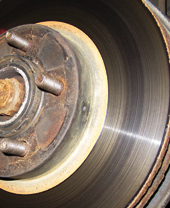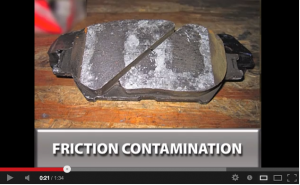The video below from Akebono is a must see for anyone who installs brake pads. It makes the points that there are two types of friction materials and a lot of ways to screw up an expensive set of pads.
When you watch the first 30 seconds of the video, they show several examples of contaminated brake pads. These pads are not contaminated by brake fluid or radioactive waste, they are contaminated by incompatible friction materials left behind by the previous set of pads.
So friction is friction right? Wrong. There are two types of friction when it comes to brakes.
Abrasive friction is the breaking of bonds of both the pad material and the cast iron of the disc when the caliper pushes them together. Adherent (or adhesive) pad material forms a very thin transfer layer of pad material on the surface of the rotor. The two surfaces are the same materials and generate friction by breaking or shearing the bonds in the pad.
Abrasive friction is the wearing of the pad and rotor to change forward motion into heat. Both components wear. Semi-met pads and some non-asbestos-organics use this type of friction.

Adherent (or adhesive) pad material transfers a very thin layer of pad material onto the surface of the rotor. Ceramic and some NAO pads use this type of friction. The transfer layer is bonded to the rotor’s surface and cannot be washed away by water or wheel cleaners. The only way to remove it is by removing it with a brake lathe or abnormal heat.
The layer is always being worn and replenished by the brake pad during braking. These pads produce dust. Adherent friction is easier on rotors, but the pads become the primary wear component.
With this type of pad, it is critical to machine the rotor with the correct surface finish and follow the recommended break-in procedure so the transfer layer can be established.
With both types of friction, it is critical for the rotor to have minimal runout. Abrasive friction materials will wear away at high spots creating disc thickness variation and pulsation. Adhesive or adherent friction material could deposit the friction material unevenly and cause brake judder.
